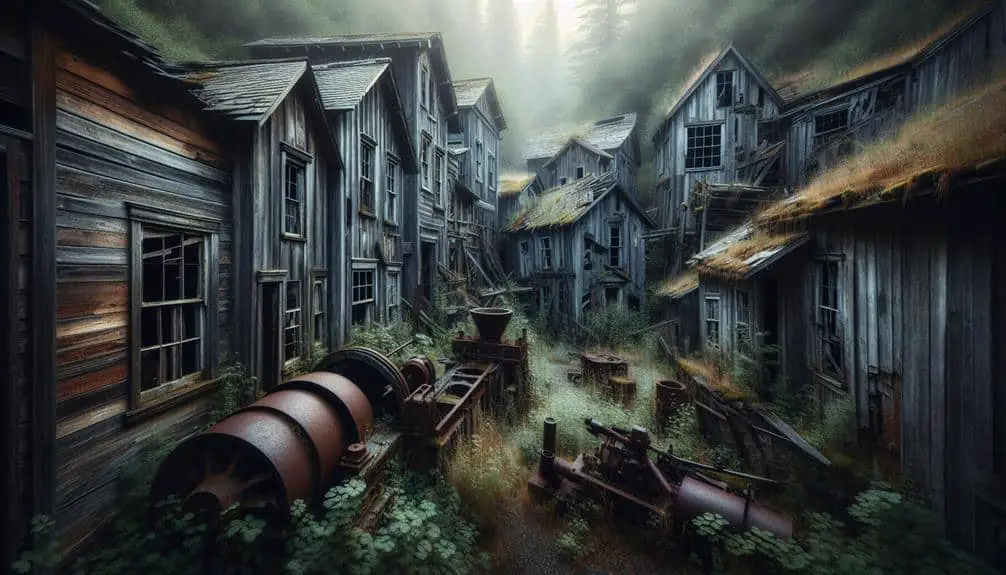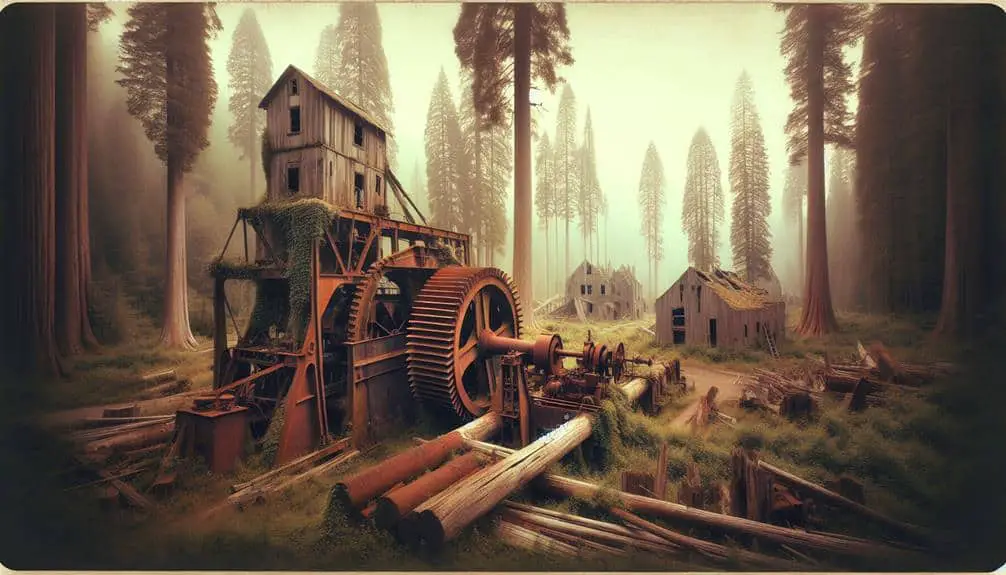Explore the ghostly remnants of Maine's historic logging towns, Oregon's forgotten lumber communities, Michigan's eerie abandoned sawmill settlements, Washington's decaying timber villages, and California's haunting logging outposts dotting the US. Each location offers a glimpse into the past timber industries and the impact on these communities. Witness the resilience of these forgotten towns amidst industry changes, and reflect on the legacy left behind by loggers. The preservation efforts in these areas aim to safeguard history and educate future generations about the transient nature of industries. Immerse yourself in the somber beauty and echoes of the past at these decaying sites.
Key Points
- Maine, Oregon, Michigan, Washington, and California have abandoned logging towns.
- These towns offer insights into the historical timber industry.
- Preservation efforts aim to safeguard the history of these towns.
- Decaying structures reflect the transient nature of industries.
- Exploring these sites connects people with the states' logging heritage.
Historic Logging Towns in Maine
Maine, known for its rich logging history, is home to several abandoned logging towns that offer a glimpse into the state's past. These historic logging towns stand as a reminder of Maine's once-booming timber industry and the communities that thrived around it. The preservation of these sites is important for maintaining the state's historical heritage and providing insights into the economic impact of logging on local economies.
Historic preservation plays a significant role in safeguarding the stories and structures of these abandoned logging towns. By protecting these sites, we can guarantee that future generations have the opportunity to learn about Maine's logging legacy and the people who contributed to its development. Exploring the economic impact of these towns sheds light on how logging shaped Maine's economy and influenced the livelihoods of its residents.
Visiting these abandoned logging towns in Maine offers a unique opportunity to connect with the state's history and appreciate the sacrifices and hard work of those who built these communities. By supporting historic preservation efforts, we can keep these stories alive and honor the legacy of Maine's logging past.
Forgotten Lumber Communities in Oregon
Exploring the dense forests of Oregon reveals a hidden history of forgotten lumber communities that once thrived amidst the towering trees. Oregon's timber industry decline has left behind remnants of these once-bustling logging towns, serving as a reminder of the state's rich lumber heritage. The echoes of sawmills and logging operations resonate through the now quiet forests, hinting at a bygone era when these communities were bustling with activity.
Efforts towards logging town preservation in Oregon have been ongoing, with initiatives aimed at documenting the history of these communities and safeguarding what remains of their structures. Historical societies and local organizations have worked diligently to guarantee that the legacy of these towns isn't entirely lost to time. By protecting artifacts and stories from these forgotten lumber communities, Oregon is able to honor its past and educate future generations about the importance of the timber industry in shaping the state's history.
As you wander through Oregon's forests, take a moment to reflect on the lives of those who once called these logging towns home, and appreciate the resilience of these communities in the face of industry changes.
Abandoned Sawmill Settlements in Michigan
Amidst the dense forests of Michigan lie remnants of abandoned sawmill settlements, silent witnesses to a bygone era of industry and community. These settlements, once bustling with the sounds of saws and the shouts of workers, now stand as eerie proofs to a once-thriving past. Rustic loggers' cabins, weathered by time and neglect, dot the landscape, offering glimpses into the lives of those who toiled in the timber industry.
The sawdust trails that once marked the paths of busy workers are now overgrown, reclaimed by nature as the forests slowly encroach upon the abandoned settlements. Walking through these ghostly sites, one can almost hear the echoes of the past, the distant hum of machinery, and the camaraderie of a community built around hard work and perseverance.
As you explore these abandoned sawmill settlements in Michigan, take a moment to reflect on the resilience of the human spirit and the fleeting nature of industry. In these quiet woods, where nature reigns supreme, the legacy of the loggers lives on, etched into the very fabric of the land.
Decaying Timber Villages in Washington
Remnants of decaying timber villages in Washington serve as somber reminders of a once-thriving industry now lost to time and neglect. The timber industry decline in the region has left behind ghostly communities where buildings stand as silent witnesses to a bygone era.
Despite this decline, there's a glimmer of hope in the form of urban renewal efforts aimed at repurposing these decaying structures. Rural revitalization initiatives are slowly breathing new life into these forgotten villages, with community preservation at the forefront of these endeavors.
Ghostly Logging Outposts in California
Nestled among the forests of California lie abandoned logging outposts, standing as silent affirmations to a once-thriving industry now lost to time and neglect. These ghostly logging outposts hold stories of rugged loggers and the echoes of falling timber that once filled the air.
Haunted cabins, their weathered walls whispering tales of bygone eras, add an eerie charm to these deserted sites. As you explore these remote locations, you may stumble upon lost artifacts, remnants of a bustling past now enveloped in quiet solitude.
Each decaying structure serves as a reminder of the transient nature of industries and the resilience of nature reclaiming its territory. The rusted tools and dilapidated machinery scattered around paint a picture of a bygone hustle and bustle that has since dissipated into the serenity of the wilderness.
These abandoned outposts stand as historical markers, urging you to ponder the passage of time and the impermanence of human endeavors in the face of nature's relentless march.
Frequently Asked Questions
What Are the Main Reasons for the Decline and Abandonment of These Logging Towns?
So, let's chat about the decline of logging towns. Environmental impact and economic factors play huge roles. Trees vanish, jobs dry up. It's like a sad song stuck on repeat. Tough times, friend.
Are There Any Efforts Being Made to Preserve or Restore Any of These Abandoned Logging Towns?
Preservation efforts are ongoing for some abandoned logging towns, aiming to protect their historical significance. Restoration projects seek to breathe new life into these forgotten places, honoring their past while creating a future.
How Did the Logging Industry Impact the Local Environment and Wildlife in These Areas?
The logging industry's impact on the local environment and wildlife was significant. Trees were felled in masses, disrupting ecosystems. Some areas became desolate. Conservation efforts are vital to restore balance and protect habitats.
What Was Daily Life Like for Residents in These Abandoned Logging Towns?
In those abandoned logging towns, daily routines revolved around hard work. Social dynamics were tight-knit, neighbors relying on each other. Despite challenges, a sense of community thrived, making life in the town unique.
Are There Any Ghost Stories or Urban Legends Associated With These Abandoned Logging Towns?
Ghost stories and mysterious disappearances often shroud abandoned logging towns. Tales of spectral loggers and eerie happenings play into the lore. These towns hold a haunting allure, drawing in those intrigued by the unknown.



